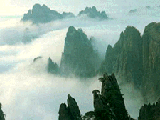 In the face of booming tourism that can easily herald environmental degradation, Mount Huangshan in east China's Anhui Province has fended off the problems -- from waste treatment and biodiversity to forest fire -- which plague many scenic spots across the world.
In the face of booming tourism that can easily herald environmental degradation, Mount Huangshan in east China's Anhui Province has fended off the problems -- from waste treatment and biodiversity to forest fire -- which plague many scenic spots across the world.
Several times a day, workers in bright yellow work suits labor their way up and down the 72 peaks of the 154-square-kilometer scenic attraction, collecting whatever is discarded by visitors.
"For any litter we neglect -- a cigarette stub or a slip of paper -- we lose some credits from our total of 100," said Ye Weicheng, a cleaner at one of the most crowded sections. "If your credits fall below 85 in two weeks, you get no bonus and might even lose your job."
In Autumn, the best season to tour the mountain, visitors from home and abroad flock to Mount Huangshan and climb up and down its many peaks along a 70-kilometer stone-paved path.
Though some have predicted the appearance of a 73rd peak ? one of waste -- as Mount Huangshan produces 4,500 tons of waste each year, the management of Mount Huangshan has taken a series of "primitive" but quite effective measures to prevent the growth of any garbage mount.
They have set up a 200-member team of environmental workers and six waste treatment centers that treat 12.5 tons of waste a day. This involves an investment of over 3 million yuan (US$360,000) annually.
Cleaner Ye Weicheng said on his dozens of trips each day up and down the 370 stone steps leading to the "True Man Peak," he collects at least 50 kilograms of waste.
"I wear out a pair of gym shoes a month on average," he added.
To some tourists who habitually litter, Ye and his colleagues have been an example.
Xie Zhongsu, 48, said he tried to interfere when he saw a visitor throw an empty plastic bottle down the mountain last year. But the man said to him rudely, "You might lose your job if nobody litters anything."
Without a word, Xie cast loose a coil of rope down the 70-meterhigh peak and hooked the bottle before he followed the tourist group to pick up whatever they littered along the way.
"After I followed them for one kilometer, all the 20 members of the group were moved," Xie recalled. "They bowed to me and promised they would never litter anything again."
The environmental workers are also responsible for catching buds and worms that reproduce rapidly in the mountain during and after the April-July rainy season, a nuisance to trees and people alike.
"We do not use pesticide to kill the insects as most chemicals are harmful to the environment," said Yao Jianfei, an official with the administrative office of Mount Huangshan.
The management has boosted the workers' enthusiasm in the chore by buying these insects -- most of which are important materials used in traditional Chinese medicine -- from them at considerably high prices.
Xie Yongxiao, a young cleaner in the mountain, has made some 2,000 yuan (US$240) for the 50 kilograms of buds he caught in May and June.
"As environmental workers we are bound to do whatever is good for the environment, even if we don't get extra payment," said Xie.
To protect the rich forest resources from worms and the various epidemics they spread, the management has set up over 30 quarantine centers to carry out routine checks on the trees and keep infected lumber from the wood.
Visitors to Mount Huangshan now have to pay a high price if they want to spend a night in the mountain, as hotel rooms have been reduced by 40 percent to curb waste and sewage.
"With the price leverage, we have diverted most visitors to hotels outside the mountain," said an official.
On the other hand, the management has removed over 40,000 square meters of makeshift buildings -- largely temporary lodgings and offices for workers -- on the mountain over the past decade, so that more trees can be planted.
In the 1980s, a three-year visitor ban was imposed on the most frequented areas in Mount Huangshan to protect the ecological environment and maintain biodiversity.
Gardeners spent the three years reinforcing old trees and planting grass on the roads and between rocks in an effort to make the mountains green, avoid soil erosion and create a natural firewall.
Meanwhile, the management has stepped up efforts to protect the mountain from fire. They have dug ponds along major roads that can save 180,000 cubic meters of water to be used in case of a forest fire, and a 50-member fire brigade is patrolling in the mountains throughout the day to watch out for signs of a potential fire and promote fire prevention ABCs to visitors.
Qu Geping, a senior official on environmental protection with the Chinese parliament, praised Mount Huangshan's efforts as "effective" and "internationally advanced".
"Some measures might seem awkward, but whatever is effective is the best," he said.
Known for its spectacular rocky peaks, odd-shaped pines, crystal-clear hot springs and seas of cloud, Mount Huangshan is listed as a World Heritage Site by the United Nations Educational, Scientific and Cultural Organization.
(Xinhua News Agency November 5, 2002)
|

